These Are Probably The Best Scones You'll Ever Eat
But first, you'll have to bake them. These luscious double cream scones are made with a recipe adapted from the lovely one at UK cookery school, Thyme. And they're to die for.

Recently, we learned how to make authentic scones at charming culinary school, Thyme, in the English countryside of Cotswolds. The lesson was simple enough, and the scones were sublime. So as soon as we got back to Singapore, we tried to replicate the teatime treat. However, the ingredients included double cream — abundant in the UK, as rare as an uncomplaining Singaporean on Facebook. We finally managed to track down some at Cold Storage supermarket. But by god, it was an eye-watering $9.50 for just 200ml (you'll need only 50ml for this recipe). And because it contains no preservatives, it goes bad faster than you can say "fattening!" So use the leftovers after baking to eat with your scones the same day you open the tub. It's stiffer in texture than what we used in the UK, but it's better than nothing.
Gippsland pure double cream: available at Cold Storage supermarket ($9.50/200ml).
Still, we're glad we'd gone to all that trouble. A dash of double cream gives these scones a subtle lushness that regular whipping cream (we tried using that too) just cannot achieve. Denser double cream, skimmed from the surface of milk, boasts a butterfat content of at least 48 per cent — regular whipping cream contains just 35 per cent. Yet, because this recipe is tempered with a fair amount of milk, what you get is a scone that's not too heavy, but instead, incredibly light and feathery once broken apart. A dreamy contrast to its crisp, golden exterior.
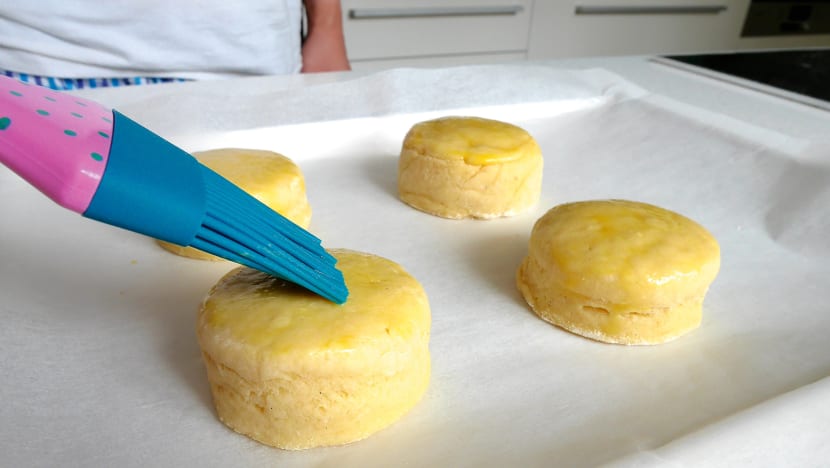
Double Cream Scones
Makes 10 - 12 pcs
Ingredients:
1 egg (65g with shell on)
50ml double cream (try Gippsland, from Cold Storage)
180ml milk
½ tsp pure vanilla paste or extract
450g self-raising flour, plus extra for dusting
½ tsp baking powder
a large pinch of salt
50g caster sugar
110g unsalted butter, cut into ½-inch cubes and chilled
For the glaze:
1 egg, beaten with 1 tbsp milk, for brushing
Equipment: 2¼ inch-wide (5.7cm) round pastry/cookie cutter
Method:
1. Preheat oven to 180°C.
2. In a jug, beat the egg, double cream, milk and vanilla with a fork till well mixed. Set aside.
3. Sift flour, baking powder and salt into a mixing bowl. Whisk in sugar.
4. Add cold butter cubes to flour mixture, using fingers to toss the cubes in the flour to coat. Quickly rub in butter with fingertips from a height (to aerate flour) until they resemble rough, dry breadcrumbs. A few pea-sized pieces are fine. Create a well in the middle of the flour mixture.
5. Pour egg and double cream mixture into the well. Stir gently with a fork till everything just comes together to form a soft, shaggy dough.
6. Using hands or a bench scraper, gather dough together and turn it out onto a floured surface.
7. Using as little pressure as possible, gently fold dough in overlapping directions about 4 – 6 times, till the surface looks less craggy. Lightly pat dough into a circle.
8. Sprinkle a little more flour on the dough if it’s too sticky, then use fingers to pat or lightly roll it with a rolling pin to about 2.5cm thick.
9. Dip a round pastry cutter thoroughly in flour, then firmly stamp out 6 scones. Press the cutter straight down, then lift it straight up. Do not twist the cutter — doing so ‘seals’ the sides and prevents the scones from rising up tall and straight.
10. Gently gather remaining dough together, lightly re-roll and cut out discs once more.
11. Transfer scones to a lined baking tray, leaving two inches of space between each piece. Brush the tops lightly with the egg and milk glaze.
12. Bake scones for 17 – 19 minutes in the centre of the oven, or until well risen and golden-brown — the bottoms should be lightly golden too. A skewer inserted into the middle of a scone should emerge clean (or knock scones, they should sound light and hollow).
13. Transfer scones to a wire rack to cool briefly till warm. Serve immediately, with jam and double cream.
Make ahead: Can't finish your scones? Freeze them after you’ve cut out the raw dough discs. Place them on a baking tray and pop into the freezer. Once frozen, transfer scones to an airtight bag and return to the freezer, for up to a week. When ready to eat, place frozen scones on a lined baking tray, brush with egg and milk, then bake for 24 - 25 minutes at 180°C.
Photos: Florence Fong





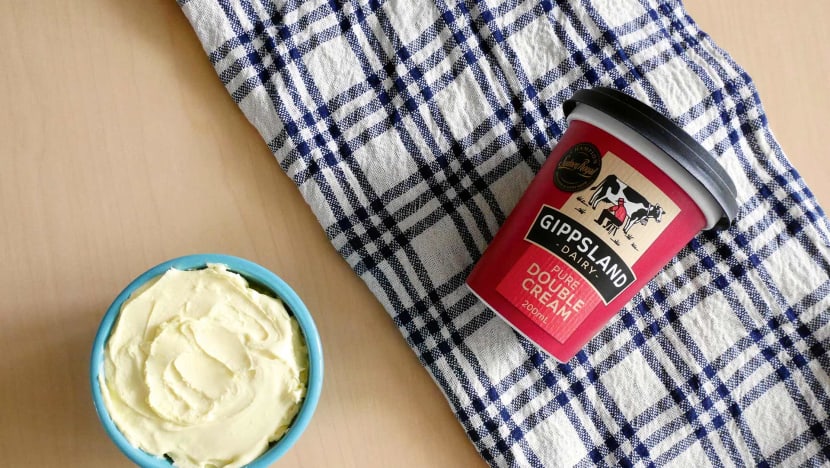
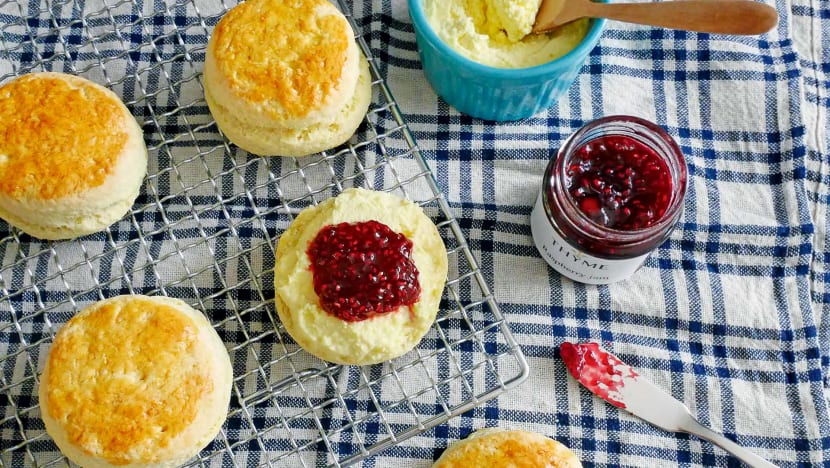

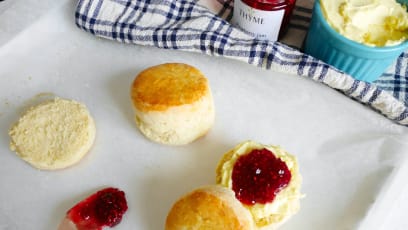
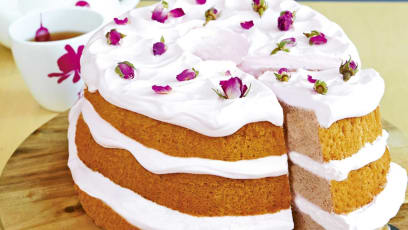
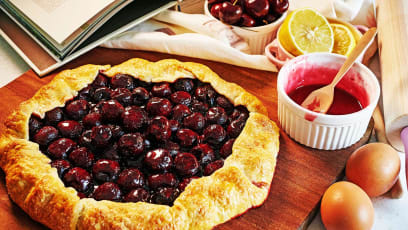




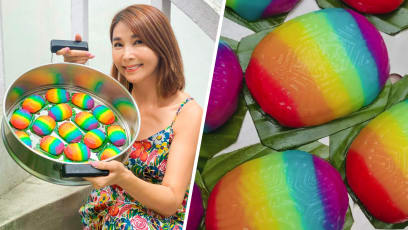

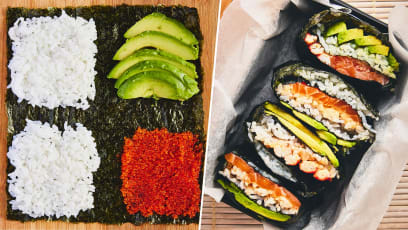




![We stan a kind-hearted boss with a good heart! 💕 Link in bio to read more
📍Rui Ji Chicken Rice
Blk 93 Toa Payoh Lor 4,
#01-48, S310093
📍148 Beach Road,
#B1-01 The Gateway,
S189720
📍Blk 305 Ubi Ave 1,
#01-179, S440305
[till 16 Apr 2024]
https://tinyurl.com/5dudypkh](https://onecms-res.cloudinary.com/image/upload/s---y3eV-Ts--/c_fit,h_396,w_223/f_auto,q_auto/v1/8days-migration/17999638880322602.jpg?itok=Tiqm3SVR)








